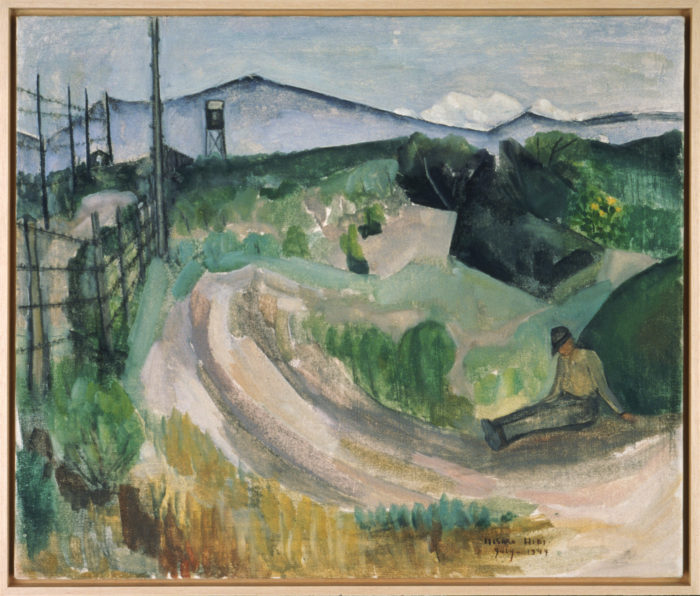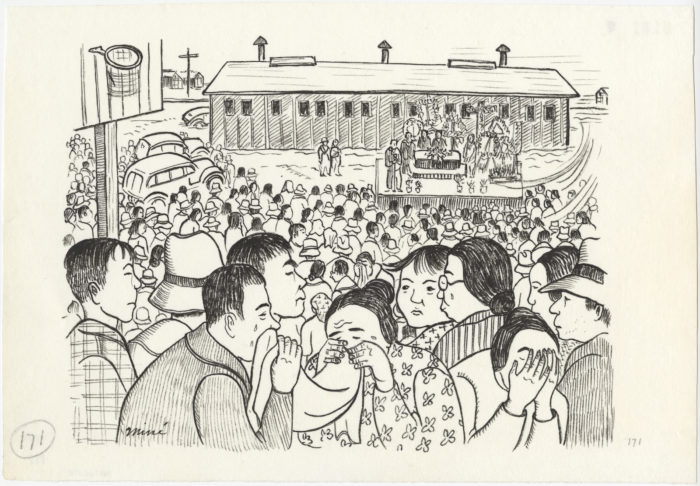Security2

Hisako Hibi, Untitled (A man in contemplation), 1944, oil on canvas, Japanese American National Museum, Gift of Ibuki Hibi Lee (96.601.34)
Click to open full-size image in new tab.Look closely at this artwork.
- What do you observe?
- What is depicted?
Consider setting, mood, color.
- Is there anything that stands out to you?
Notice the barbed-wire fence and guard tower depicted on the left side of the painting.
- What do you think their function is, and why did the artist include them in this image?
Notice the solitary figure.
- How would you describe him?

Japanese American National Museum, Gift of Frank S. Emi (96.109.32)
Click to open full-size image in new tab.Like the fence and guard tower depicted in the painting of Topaz, similar means of security existed at the other camps. This photograph is from a different camp at Heart Mountain, Wyoming. It is inscribed on the back.
- Who is being protected by these fences and towers?
- What are these fences and guards protecting against?
- If you were surrounded by barbed wire like this how would it make you feel? Would you feel fearful, feared, secure, anxious?
Security guards armed with guns kept a watchful eye on the interior of the camp from inside the towers while military police patrolled the external areas.

“Questions and Answers for Evacuees: Information Regarding the Relocation Program” pamphlet, 1942, Japanese American National Museum, Gift of Norio Mitsuoka (91.19.6B)
Click to open full-size image in new tab.This is part of a pamphlet the War Relocation Authority distributed to Japanese Americans as it was preparing to remove them from their homes. As you read the definitions, pay close attention to word choice, noting phrases such as “convenient gathering point”; “opportunity for orderly, planned movement”; and “pioneer community with basic housing and protective services provided by the Federal Government.”
- What would you say is the purpose of this pamphlet?
- What message and/or feeling is it trying to convey?
- What is the tone of this pamphlet?
Knowing what we now know about America’s concentration camps:
- Do you think this pamphlet accurately conveys to Japanese Americans what they should expect upon being removed from their homes and incarcerated?
- Do you think this pamphlet made Japanese Americans feel more comfortable about what they were experiencing?
- Would you replace any words in the pamphlet with more accurate terminology? What words would you replace and what would you replace them with?

Miné Okubo, Untitled (Preparing wreaths for Wakasa memorial, Central Utah Relocation Project, Topaz, Utah, 1942–44), c. 1942–44, ink on paper, Japanese American National Museum, Gift of the Miné Okubo Estate (2007.62.179)
Click to open full-size image in new tab.Examine this drawing by Miné Okubo.
- What event is being depicted in this image and what evidence do you see that communicates this?
- What is the mood of this drawing?
This is a depiction of the funeral service for 63-year-old James Wakasa, an inmate at Topaz War Relocation Center. On April 11, 1943, Mr. Wakasa, an Issei, was fatally shot by a guard while walking his dog on the inside of the fence at the Topaz War Relocation Center. According to the guard, Mr. Wakasa was walking too close to the edge of the camp’s barbed-wire fence and, despite verbal warnings, he didn’t move away or turn around. People who knew Mr. Wakasa said he was hard of hearing and most likely didn’t respond to the guard because he didn’t hear him, not because he was disobedient. The guard, Private First Class Gerald Philpott, was found not guilty in a court-martial trial.

Hisako Hibi, Untitled (A man in contemplation), 1944, oil on canvas, Japanese American National Museum, Gift of Ibuki Hibi Lee (96.601.34)
Click to open full-size image in new tab.The government said the fences and towers were there to protect the inmates. However, the memories of those who recall soldiers’ guns pointed at the inmates, and events like the killing of James Wakasa, indicate these protective measures were in fact meant to secure the Japanese Americans out of fear they were a dangerous threat to those outside the camps.
Hisako Hibi, the artist who painted this image, recounts a day at the Tanforan Assembly Center when she ventured near the barbed wire fence with her sketchbook. She writes:
“I was busily moving the color pencil sand crayons on the paper when an internal security officer came and took away the sketch without saying a word. I was terrified and too afraid at the time to ask him what was wrong with sketching that scene.”
